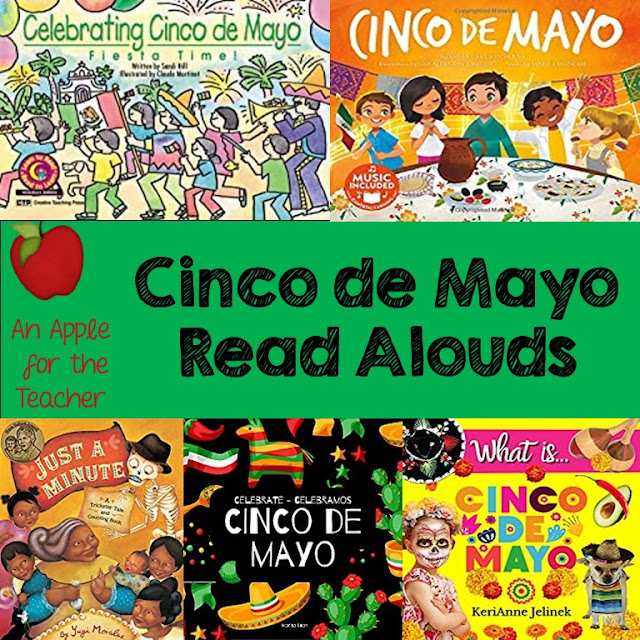Cinco de Mayo is a celebration of Mexican heritage and pride that takes place on May 5th every year. It commemorates the Mexican army's victory over the French at the Battle of Puebla on May 5, 1862.
To celebrate Cinco de Mayo in your classroom, you can incorporate read-alouds that introduce your students to the history and traditions behind the holiday.
This post contains affiliate links. I earn a small commission each time someone makes a purchase using one of my links, which helps to support the blog. All opinions are my own and I only promote brands and products that I have used myself and truly love.
Here are some great Cinco de Mayo read-alouds and lesson ideas to go with each book.
Celebrating Cinco de Mayo by Sandi Hill
This book provides a more in-depth look at the traditions and customs associated with Cinco de Mayo.
Reading: Have students
read the book independently and then come together in small groups to discuss
what they learned and any questions they have.
Math: Create a bar graph
showing the number of Cinco de Mayo celebrations that take place in different
parts of the world. Have students compare and contrast the data.
Writing: Have students write a Cinco de Mayo recipe, including the ingredients and steps needed to make a traditional Mexican dish.
Social Studies: Discuss the cultural significance of Cinco de Mayo and the ways it is celebrated in different parts of the world.
With its lively illustrations and captivating read-aloud text, this authentic trickster tale pays homage to the vibrant traditions of Mexican culture while also serving as an excellent introduction to counting in Spanish.
Reading: Have students
practice counting in Spanish as they read the book aloud.
Math: Create a number
line with the numbers 1-10 in Spanish. Have students use the number line to
practice counting in Spanish.
Writing: Have students
write a short story or fable using a trickster character from Mexican folklore.
Science: Discuss the
animals that are featured in the book, including the lizard and the crow. Have
students research these animals and create a presentation about their habitat,
diet, and behaviors.
Social Studies: Discuss the history and culture of Mexico and the ways it has influenced the United States. Have students research Mexican-American leaders and their contributions to society.
This book is part of the Holidays in Rhythm and Rhyme series, which celebrates holidays
through poetry and music. Cinco de Mayo is a great way to introduce
the holiday's history to young readers. The book includes colorful illustrations
and rhythmic poetry that will captivate children's attention.
Reading: Have students read the book together in class, taking turns reading each stanza.
Then, have them discuss what they learned about the holiday.
Writing: Have the
children write a poem or story about a fictional character who played a role in
the Battle of Puebla.
Science: Research and
discuss the different types of plants and animals found in Mexico, and how they
differ from those found in other parts of the world. What adaptations help them to survive?
Social Studies: Learn about Mexican culture, including traditional clothing, food, music, and dance.
This bilingual book is
perfect for children who are learning English and Spanish. It includes colorful
illustrations and simple language that will engage young readers.
Reading: Have the
children read the book together, alternating between English and Spanish. Then,
have them discuss what they learned about the holiday.
Math: Use the book to
teach children about the different types of food and drinks that are commonly
served during Cinco de Mayo celebrations. Have students create a menu and
calculate the total cost of the items. They could also write word problems that can be solved using their menu.
Writing: Have students write a letter in Spanish to a pen pal in Mexico, describing how they
celebrate Cinco de Mayo in their own community.
Science: Learn about the
geography of Mexico and the different regions of the country. Discuss the
different types of plants and animals found in each region.
Social Studies: Learn about the different holidays and celebrations that are unique to Mexico, including Dia de los Muertos, Las Posadas, and Cinco de Mayo.
This book provides a
comprehensive overview of Cinco de Mayo and its cultural significance. It
includes colorful illustrations and engaging text that will capture children's
imaginations.
Math: Use the book to
teach students about the different types of Mexican currency. Have the students convert the amounts into their own currency and discuss the differences.
Writing: Have the children write a persuasive essay arguing why Cinco de Mayo should be celebrated as a national holiday in their own country
Incorporating
read-alouds into your Cinco de Mayo celebrations is a great way to introduce
your students to the history and traditions of this important holiday. By
incorporating math, writing, science, and social studies activities, you can
help your students gain a deeper understanding of Mexican culture and the
significance of Cinco de Mayo.



































